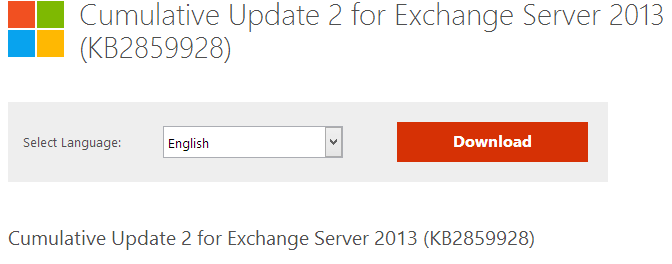This post is also available in: angielski
W dniu wczorajszym 29.07.2013 Exchange Team poinformował o wydaniu nowej wersji CU2 dla Exchange 2013 RTM.
Nowa wersja została wydana w związku z problemami pojawiającymi się po instalacji CU2 przy obsłudze folderów publicznych, dlatego jest zalecane zainstalowanie najnowszej wersji CU2.
Pisaliśmy o tym w poście:
Exchange 2013 CU2 powoduje zmianę uprawnień przy przeniesieniu Public Folder Mailbox
Nowe wydanie CU2 ma numer wersji: 15.0.712.24 (KB2859928)
Możecie go pobrać ze strony Microsoft Download Center:
Cumulative Update 2 for Exchange Server 2013 (KB2859928)
Jeżeli nie zainstalowaliście do tej pory CU2 dla Exchange 2013, po prostu instalujecie najnowszą wersję CU2 z numerem build 15.0.712.24 (KB2859928). Sposób instalacji opisany jest na końcu tego posta.
Jeżeli natomiast już macie zainstalowany CU2, który był wydany 09.07.2013 z numerem build 15.0.712.22, wówczas musicie pobrać nowy CU2 i zainstalować go wpisując komendę:
setup.exe /m:upgrade /IAcceptExchangeServerLicenseTerms
Również tak samo można uruchomić instalacje z kreatora CU2.
Nie zalecane jest wcześniejsze odinstalowanie CU2 w poprzedniej wersji, aby zainstalować nową wersję CU2.
Instalacja CU2 dla Exchange 2013 RTM:
Unlike previous versions, cumulative updates do not use the rollup infrastructure; cumulative updates are actually full builds of the product, meaning that when you want to deploy a new server, you simply use the latest cumulative update build available and do not necessarily need to apply additional Exchange Server updates.
Active Directory Preparation
Prior to upgrading or deploying the new build onto a server, you will need to update Active Directory. For those of you with a diverse Active Directory permissions model you will want to perform the following steps:
- Exchange 2013 RTM CU2 includes schema changes. Therefore, you will need to execute setup.exe /PrepareSchema /IAcceptExchangeServerLicenseTerms.
- Exchange 2013 RTM CU2 includes enterprise Active Directory changes (e.g., RBAC roles have been updated to support new cmdlets and/or properties). Therefore, you will need to execute setup.exe /PrepareAD /IAcceptExchangeServerLicenseTerms.
Note: If your environment contains only Exchange 2007, and you upgrade to Exchange 2013, keep in mind you cannot deploy Exchange 2010 in that environment at a later time. If you foresee a need to deploy Exchange 2010 servers into your environment, deploy an Exchange 2010 multi-role server (with all four servers roles) prior to executing Exchange 2013 setup.exe /PrepareAD. As long as you retain at least one role of each legacy server, you will continue to be able to install additional servers of that version into your coexistence environment. Once you remove the last server role of a legacy version, you will no longer be able to reintroduce that version into the environment.
Server Deployment
Once the preparatory steps are completed, you can then deploy CU2 and start your coexistence journey. If this is your first Exchange 2013 server deployment, you will need to deploy both an Exchange 2013 Client Access Server and an Exchange 2013 Mailbox Server into the organization. As explained in Exchange 2013 Client Access Server Role, CAS 2013 is simply an authentication and proxy/redirection server; all data processing (including the execution of remote PowerShell cmdlets) occurs on the Mailbox server. You can either deploy a multi-role server or each role separately (just remember if you deploy them separately, you cannot manage the Exchange 2013 environment until you install both roles).
If you already deployed Exchange 2013 RTM code and want to upgrade to CU2, you will run setup.exe /m:upgrade /IAcceptExchangeServerLicenseTermsfrom a command line after completing the Active Directory preparatory steps or run through the GUI installer. Deploying future cumulative updates will operate in the same manner.



 English
English  polski
polski